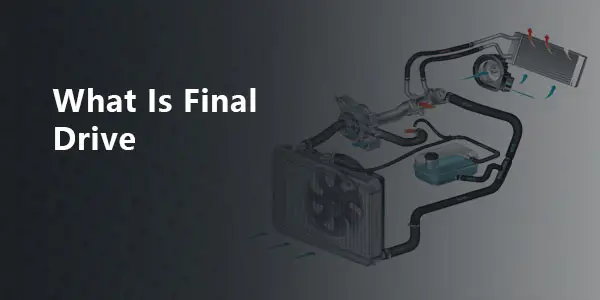What Is Final Drive
What Is Final Drive
The final drive is the assembly of gears in the rear axle of rear-wheel drive vehicles and the front axle of front-wheel drive vehicles. The final set of gears in the drive train is the final drive.
When the final drive is on the axle, the spinning wheels have to move at different speeds as the machine navigates the bend. On front-wheel-drive cars, the transmission is usually combined with the final drives to form what's known as a transaxle.
On heavy construction equipment, final drives transfer power from the driveline to the tires or tracks using a gear system designed to reduce speed and increase torque. A final drive is the last component in a machine's powertrain, followed by the final component that increases torque through gear reduction or redirection of power flow.
The final drive parts are part of the undercarriage parts. Final drives are made up of different final drive belt components and exist in a variety of machine types, makes, and models. Although they generally share many of the same basic concepts, the way final drives are implemented and Types and even machine manufacturers are unique.
How Does Final Drive Ratio Work?
The ratio of the instantaneous input speed to the output speed in the device is called the transmission ratio of the mechanism.
The ratio of the angular velocities of the two rotating components in the equipment is also known as the speed ratio. The transmission ratio of component a and component b is I=ωa/ωb=na/nb, where ωa and ωb are the angular speeds of components a and b respectively, na and nb are the rotational speeds of components a and b respectively. When the angular velocity in the formula is an instantaneous value, the obtained transmission ratio is the instantaneous transmission ratio. When the angular velocity in the formula is the average value, the obtained transmission ratio is the average transmission ratio.
For most gear drives and friction wheel drives with correct tooth profiles, the instantaneous transmission ratio is constant. For chain drives and non-circular gear drives, the instantaneous transmission ratio is variable. For meshing transmission, the transmission ratio can be expressed by the number of teeth Za and Zb of wheels a and b, i=Zb/Za; for friction transmission, the transmission ratio can be expressed by the diameter of wheels a and b and b, i=b/a. At this time, the transmission ratio generally means the average transmission ratio. In hydraulic transmission, the transmission ratio of hydraulic transmission components generally refers to the ratio of the turbocharger speed to the pump wheel speed B, that is, =/B. Hydraulic transmission elements can also be used in combination with mechanical transmission elements to obtain transmission ratios of various values.
What Causes A Final Drive to Fail?
The main causes of transmission system failure are:
- The speed of the hydraulic transmission system is abnormal. Faults due to abnormal speed need to adjust the variable structures such as the throttle valve, overflow valve, variable pump, and speed control valve one by one, and then compare and analyze the speed range value and technical reference value corresponding to the speed range value.
- The hydraulic transmission system is abnormal. Faults due to abnormal actions need to observe the action status of the relevant system actuators and judge whether they are normal according to their active status. Find out the reversing valve that is operating abnormally, and then check the stroke control to find out the abnormal place in the hydraulic transmission system.
- The pressure of the hydraulic transmission system is abnormal. To determine whether there is a fault due to abnormal pressure, it is necessary to use a pressure gauge to measure the pressure value on the reserved pressure measuring point on the system pipeline, and then analyze the difference between the measured value and the standard value to obtain the cause of the abnormal pressure of the hydraulic transmission system Location.
 Track Your Order
Track Your Order




